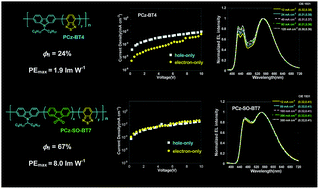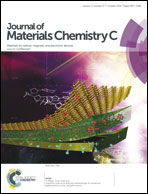Improving the efficiency and spectral stability of white-emitting polycarbazoles by introducing a dibenzothiophene-S,S-dioxide unit into the backbone
Abstract
Highly efficient and spectral stable white-emitting copolymers based on 2,7-carbazole (Cz), dibenzothiophene-S,S-dioxide (SO) and benzothiadiazole (BT) units (PCz–SO–BT)s were designed and synthesized via Suzuki polycondensation. High fluorescence quantum yield (∼70%) and balanced charge transport were achieved by introducing a SO unit into the PCz–BT backbone. A peak luminous efficiency (LEmax) of 8.2 cd A−1, a maximum power efficiency (PEmax) of 8.0 lm W−1 (corresponding to a maximum external quantum efficiency of 3.9%) and a maximum luminance (Lmax) of 13 526 cd m−2 with the CIE coordinate of (0.32, 0.41) were obtained from a single-layer device of ITO/PEDOT:PSS/PCz–SO–BT7/CsF/Al. The electroluminescence (EL) efficiencies were improved about 4 times compared to the case of SO absent copolymer PCz–BT4. Moreover, the EL spectra of PCz–SO–BTs exhibited dramatic stability with the variation of driving current densities from 12 to 300 mA cm−2, which could be attributed to the electron detrapping by decreasing the difference of the lowest unoccupied molecular orbital (LUMO) levels (ΔELUMO) between the chromophores. The results showed that the SO unit could be an excellent building block for white-emitting copolymers toward high efficiency and spectral stability.


 Please wait while we load your content...
Please wait while we load your content...